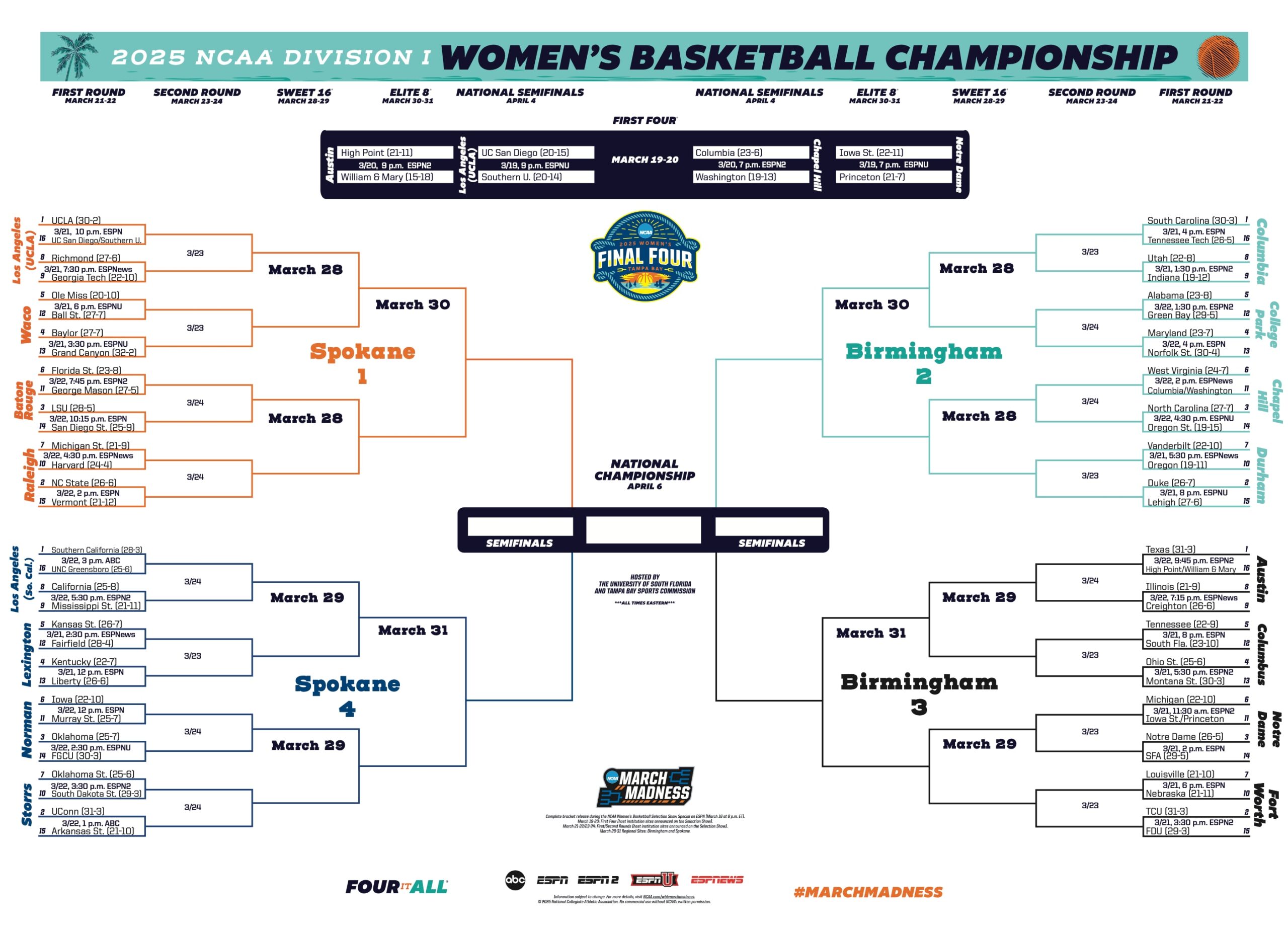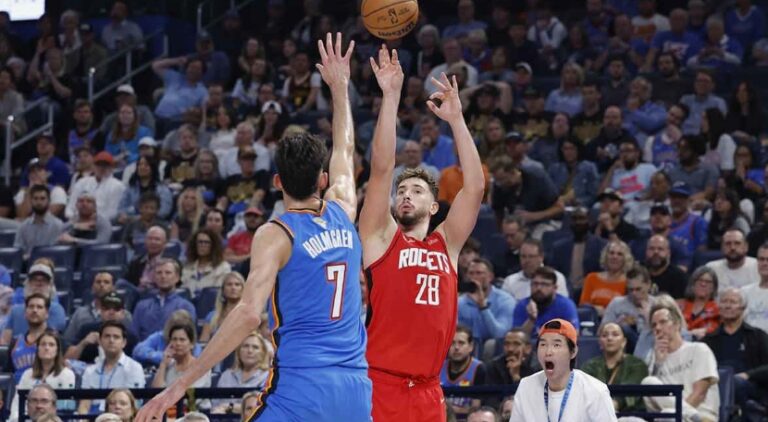
Overview of the NCAA Women’s Basketball Tournament Schedule
The NCAA Women’s Basketball Tournament is a prestigious college basketball tournament that showcases the best women’s basketball teams in the United States. It holds significant importance as it determines the national champion in women’s college basketball.
The tournament has a rich history that dates back to its inaugural year in 1982. It was initially organized by the Association for Intercollegiate Athletics for Women (AIAW) until the NCAA took over in 1982. Since then, it has grown to become one of the most popular sporting events in women’s college basketball.
The tournament follows a single-elimination format, similar to the NCAA Men’s Basketball Tournament. It involves 64 teams from various colleges and universities across the country. The selection process for the tournament teams is based on a combination of regular season records and conference tournament performances. The selection committee evaluates and ranks teams to determine the seeding and matchups for the tournament.
The NCAA Women’s Basketball Tournament typically takes place in March and April. The dates and duration of the tournament vary each year, but it generally spans over several weeks. The tournament showcases thrilling games, upsets, and the crowning of a national champion, making it an exciting event for basketball fans all over the country.
Selection and Seeding Process
The selection and seeding process for the NCAA Women’s Basketball Tournament is a crucial aspect of determining which teams get to participate and how they are ranked. Let’s take a closer look at how this process works.
Teams are selected based on a number of criteria and factors that are taken into consideration by the NCAA selection committee. These factors include a team’s overall win-loss record, strength of schedule, quality of wins against ranked opponents, and their performance in conference tournaments. The committee also looks at other metrics such as the Ratings Percentage Index (RPI) and the NCAA Evaluation Tool (NET) rankings to assess a team’s performance.
The selection process begins with conferences holding their own tournaments to determine automatic bids. Each conference champion receives an automatic bid to the NCAA Tournament, ensuring representation from all conferences. The remaining teams are then selected through an at-large process, where the selection committee chooses teams based on their overall performance and resume.
Once the teams are selected, the next step is to determine their seeding. Teams are ranked and placed into four regions, with each region consisting of 16 teams. The top-ranked team in each region is given the number one seed, while the remaining teams are seeded accordingly based on their performance and resume.
The seeding process is an important aspect of the tournament as it determines the teams’ path to the championship. Higher-seeded teams are typically given more favorable matchups in the earlier rounds, while lower-seeded teams face tougher opponents. The goal is to create a fair and competitive tournament bracket.
Controversies and debates often arise surrounding the selection and seeding process. Some argue that certain teams are unfairly left out of the tournament, while others question the committee’s decisions on seeding. The subjective nature of the process can lead to disagreements and discussions among fans, analysts, and coaches.
Overall, the selection and seeding process for the NCAA Women’s Basketball Tournament is a complex and intricate process that aims to ensure a fair and competitive tournament field. While controversies may arise, the committee’s goal is to select and seed the teams based on their performance and resume throughout the season.
Tournament Bracket and Matchups
The NCAA Women’s Basketball Tournament features a bracket-style format where teams compete in a single-elimination tournament to determine the national champion. The tournament bracket is structured with four regions, each consisting of 16 teams. The teams are seeded based on their performance during the regular season, with the top seeds receiving preferential placement.
First Four
Before the official start of the tournament, the First Four games are played to determine the final four teams that will enter the main bracket. These four games involve eight teams that are on the bubble and have a chance to earn a spot in the tournament. The winners of the First Four games advance to the First Round.
First Round and Second Round
The First Round consists of 64 teams competing in 32 games. The winners of these games advance to the Second Round, where they face off against the higher-seeded teams from the First Round. This round further narrows down the field to 32 teams.
Sweet Sixteen
The Sweet Sixteen is the third round of the tournament and features the remaining 16 teams. At this stage, the competition intensifies as teams battle to secure a spot in the Elite Eight.
Elite Eight
The Elite Eight is the fourth round of the tournament and consists of the eight teams that have advanced from the Sweet Sixteen. The winners of these games move on to the Final Four.
Final Four
The Final Four is the penultimate round of the tournament and showcases the four best teams in the nation. These games determine which teams will compete for the championship title.
Championship
The Championship game is the culmination of the tournament and features the two remaining teams vying for the national championship. This game determines the ultimate winner of the NCAA Women’s Basketball Tournament.
In past tournaments, there have been several memorable matchups and notable games. For example, in 2018, the University of Notre Dame faced off against the University of Connecticut in the Final Four. Notre Dame’s Arike Ogunbowale hit a buzzer-beating shot in overtime to secure the victory for her team. This moment became an iconic highlight of the tournament.
The NCAA Women’s Basketball Tournament has also seen its fair share of upsets and Cinderella stories. In 2013, the 12th-seeded University of Kansas made an incredible run to the Sweet Sixteen, defeating higher-seeded teams along the way. This unexpected success captivated fans and showcased the unpredictable nature of the tournament.
Locations and Venues
The NCAA Women’s Basketball Tournament games are held at various locations and venues across the United States. These venues are carefully selected to provide a memorable experience for the players and fans alike.
Significance of Locations and Traditions
Each location has its own significance and traditions associated with it. Some venues have a rich history of hosting NCAA Women’s Basketball Tournament games, becoming iconic in the sport. For example, the Final Four games are traditionally held at different host cities each year, allowing fans from different regions to experience the excitement of the tournament firsthand.
Venue Capacity and Amenities
The capacity and amenities of the venues vary depending on the location. Some arenas can accommodate tens of thousands of spectators, while others may have a smaller capacity, creating a more intimate atmosphere. These venues are equipped with state-of-the-art facilities, including high-quality playing surfaces, modern locker rooms, and media centers to ensure a smooth and enjoyable tournament experience.
Memorable Moments and Records
Throughout the years, there have been several memorable moments and records set at specific venues during the NCAA Women’s Basketball Tournament. For example, in 2019, the Amalie Arena in Tampa, Florida witnessed an incredible comeback by the Baylor Lady Bears in the championship game, securing their third national title. This game will forever be etched in the minds of fans who witnessed the thrilling victory.
Another notable moment occurred in 2018 at the Nationwide Arena in Columbus, Ohio, where the Notre Dame Fighting Irish made a buzzer-beating shot to win the national championship against the Mississippi State Bulldogs. This dramatic finish left a lasting impression on all who were present.
These venues provide the stage for extraordinary performances and historic achievements that make the NCAA Women’s Basketball Tournament a beloved event in the world of college sports.
Television Coverage and Broadcast Schedule
Television coverage plays a crucial role in promoting and popularizing the NCAA Women’s Basketball Tournament. With extensive coverage across various networks, fans have the opportunity to watch their favorite teams compete on a national stage. Let’s dive into the details of the television coverage and broadcast schedule for the tournament.
Television Networks
The NCAA Women’s Basketball Tournament is broadcasted by several prominent television networks. Some of the major networks that air the tournament include ESPN, ESPN2, and CBS Sports. These networks have a wide reach and ensure that fans across the country can tune in to watch the games.
Coverage and Commentators
The tournament receives comprehensive coverage, with multiple games aired throughout the competition. ESPN, being the primary broadcaster, covers the majority of the tournament’s matchups. They provide expert analysis, insightful commentary, and in-depth pre and post-game coverage to enhance the viewing experience.
ESPN also brings in a talented lineup of commentators and analysts who add excitement and expertise to the broadcasts. Familiar names such as Rebecca Lobo, Holly Rowe, and Doris Burke, among others, lend their voices to the tournament. Their knowledge and passion for the game enrich the viewing experience for fans.
Broadcast Schedule
The NCAA Women’s Basketball Tournament spans multiple rounds, starting with the First Round and culminating in the Championship Game. The broadcast schedule varies depending on the stage of the tournament.
During the early stages, multiple games are played simultaneously, and networks like ESPN and ESPN2 provide coverage by switching between different games. As the tournament progresses, the coverage becomes more focused on the marquee matchups and pivotal games.
Prime-time slots are reserved for high-profile games featuring top-ranked teams or historic rivalries. These games draw significant viewership and generate buzz among basketball enthusiasts. The broadcast schedule ensures that fans don’t miss out on the most exciting moments of the tournament.
Impact on Popularity and Exposure
Television coverage has a tremendous impact on the popularity and exposure of the NCAA Women’s Basketball Tournament. By broadcasting the games on major networks, the tournament reaches a wide audience, including casual sports fans who may not follow women’s basketball regularly.
The extensive coverage and high-quality production value of the broadcasts help elevate the tournament’s visibility and credibility. It provides a platform for athletes to showcase their skills and inspire young girls to pursue basketball. The exposure gained through television coverage attracts more fans and sponsors, contributing to the growth and development of women’s basketball.
In conclusion, the NCAA Women’s Basketball Tournament receives comprehensive television coverage from networks like ESPN, ESPN2, and CBS Sports. The coverage includes multiple games, expert commentary, and analysis from renowned commentators. The broadcast schedule ensures that prime-time slots and marquee matchups receive significant attention. Television coverage plays a crucial role in boosting the popularity and exposure of the tournament, contributing to the growth of women’s basketball as a whole.
Player and Team Performances
In the NCAA Women’s Basketball Tournament, there have been many standout players and teams that have left their mark on the tournament’s history. These players and teams have showcased exceptional skills, determination, and teamwork, making the tournament an exciting and memorable event.
Throughout the years, several individual and team records have been set during the NCAA Women’s Basketball Tournament. Players have achieved remarkable feats, such as scoring the most points in a single tournament, recording the most rebounds, or dishing out the most assists. Teams have also demonstrated dominance by winning multiple championships or going on impressive winning streaks.
When comparing the performances of different players and teams over the years, it becomes evident that the level of competition has continued to rise. The game has evolved, and players have become more skilled and athletic, leading to intense matchups and thrilling moments on the court.
There have been numerous memorable moments in NCAA Women’s Basketball Tournament history. From buzzer-beater shots that decided the outcome of a game to underdog teams making deep runs in the tournament, these moments have captured the attention and excitement of fans across the country. Some iconic moments include last-second shots to win the championship, unexpected upsets, and remarkable individual performances that propelled teams to victory.
Standout Players and Teams
Over the years, several players have left a lasting impact on the NCAA Women’s Basketball Tournament. Players like Breanna Stewart from UConn, Diana Taurasi from UConn, and Maya Moore from UConn have showcased their exceptional skills and leadership, leading their teams to multiple championships. These players have consistently displayed their talent and determination on the biggest stage of college basketball.
In terms of teams, the University of Connecticut has been a dominant force in the NCAA Women’s Basketball Tournament. The UConn Huskies have won multiple championships and have had remarkable winning streaks, establishing themselves as one of the most successful programs in tournament history. Their consistent success is a testament to the exceptional coaching and talent within the program.
Records and Achievements
Throughout the tournament’s history, several records and achievements have been etched in the books. For example, in 2018, Arike Ogunbowale of Notre Dame hit back-to-back buzzer-beating shots in the Final Four and championship game, securing the championship for her team in dramatic fashion. This feat will forever be remembered as one of the most clutch performances in tournament history.
Additionally, the University of Connecticut holds the record for the longest winning streak in tournament history, with 111 consecutive victories from 2014 to 2017. This remarkable achievement showcases the dominance of the UConn Huskies during that period.
Comparison of Performances
When comparing the performances of different players and teams over the years, it is clear that the level of competition has increased. With more talented athletes entering the tournament each year, the games have become more intense and closely contested. Teams that were once considered underdogs have emerged as legitimate contenders, leading to unpredictable and thrilling matchups.
Players have also showcased their versatility and skills, adapting to the evolving style of play in women’s basketball. From sharpshooters who can drain threes from deep to agile and athletic forwards who can dominate in the paint, the NCAA Women’s Basketball Tournament has seen a wide range of playing styles and strategies.
Overall, the NCAA Women’s Basketball Tournament has provided a platform for players and teams to showcase their abilities and compete at the highest level. The tournament’s rich history is filled with memorable moments, exceptional performances, and records that will be remembered for years to come.
Awards and Recognition
The NCAA Women’s Basketball Tournament presents several awards to recognize the outstanding performances of players throughout the tournament. These awards not only celebrate individual achievements but also highlight the contributions made by players to their teams’ success.
One of the most prestigious awards presented during the tournament is the Most Outstanding Player (MOP) award. This award is given to the player who demonstrates exceptional skill, leadership, and performance during the tournament. The MOP is typically a player who has made significant contributions to her team’s success, whether it be through scoring, rebounding, or facilitating the offense. Past winners of the MOP award include legendary players such as Breanna Stewart, Diana Taurasi, and Maya Moore.
In addition to the MOP award, the NCAA Women’s Basketball Tournament also recognizes the All-Tournament Team. This team is composed of the top performers throughout the tournament and is selected based on their individual contributions to their teams’ success. Being named to the All-Tournament Team is a significant honor and showcases a player’s exceptional talent and impact on the game.
These awards hold great significance for players, as they not only recognize their individual achievements but also validate their hard work and dedication to the sport. Winning the MOP or being named to the All-Tournament Team can have a lasting impact on a player’s career, boosting their reputation and opening doors to future opportunities, such as professional contracts or national team selections.
However, the awards and recognition process is not without controversy. Some critics argue that the selection process for these awards is subjective and influenced by factors such as media attention and preconceived notions about certain players or teams. This can lead to debates and disagreements regarding the deserving recipients of these awards. Despite the controversies, the awards presented during the NCAA Women’s Basketball Tournament remain an important aspect of the tournament and continue to honor the exceptional performances of players.
Impact and Influence of the NCAA Women’s Basketball Tournament

The NCAA Women’s Basketball Tournament has had a significant impact on the sport as a whole. It has contributed to the growth and development of women’s basketball and has played a crucial role in promoting gender equality in sports. Additionally, the tournament has led to the launch of various initiatives and programs aimed at further advancing women’s basketball.
Growth and Development of Women’s Basketball
The NCAA Women’s Basketball Tournament has provided a platform for female athletes to showcase their skills and compete at a high level. This exposure has helped increase the popularity of women’s basketball and has attracted more fans and supporters to the sport. The tournament has also led to the development of talented players who have gone on to have successful careers in professional basketball, both domestically and internationally.
Furthermore, the tournament has led to increased investment in women’s basketball programs across colleges and universities. As the tournament gained more attention and viewership, educational institutions recognized the potential of women’s basketball and started investing in resources, facilities, and coaching staff to develop competitive teams. This has resulted in improved training opportunities for female athletes and has raised the overall standard of play in women’s college basketball.
Gender Equality in Sports
The NCAA Women’s Basketball Tournament has been instrumental in promoting gender equality in sports. By providing equal opportunities for female athletes to compete at the collegiate level, the tournament has challenged the notion that women’s sports are inferior to men’s sports. It has showcased the incredible talent and athleticism of female basketball players and has shattered stereotypes surrounding women’s participation in sports.
Moreover, the tournament has sparked important conversations about gender equality in sports and has led to initiatives aimed at addressing the disparities between men’s and women’s sports. For example, the inequities in resources and facilities between the men’s and women’s tournaments came to light in 2021, prompting discussions about the need for equal treatment and investment in women’s sports. This scrutiny has paved the way for improvements and changes in the way women’s basketball is supported and promoted.
Initiatives and Programs
As a result of the NCAA Women’s Basketball Tournament, several initiatives and programs have been launched to further support and promote the sport. These include mentorship programs for young female athletes, leadership development programs for women in coaching and administration roles, and grassroots initiatives aimed at increasing participation in women’s basketball at the community level.
Additionally, the tournament has inspired the creation of women’s basketball leagues and professional opportunities for players after college. The success and visibility of the tournament have generated interest and investment in women’s professional basketball, providing more opportunities for female athletes to continue their careers and inspiring future generations of players.
Overall, the NCAA Women’s Basketball Tournament has had a profound impact on women’s basketball, contributing to its growth and development, promoting gender equality in sports, and sparking initiatives and programs aimed at further advancing the sport.
FAQ Section
How are teams selected to participate in the NCAA Women’s Basketball Tournament?
Teams are selected based on a combination of factors, including their regular season performance, conference championships, and overall record. The NCAA selection committee evaluates teams using various metrics and criteria to determine the most deserving participants.
What is the seeding process in the NCAA Women’s Basketball Tournament?
The seeding process involves ranking the teams based on their perceived strength and performance. The selection committee assigns each team a seed number, which determines their position in the tournament bracket. Higher-seeded teams are typically matched against lower-seeded teams in the early rounds.
How is the tournament bracket structured?
The tournament bracket is structured in a single-elimination format, where teams compete head-to-head until a champion is crowned. It consists of rounds such as the First Four, First Round, Second Round, Sweet Sixteen, Elite Eight, Final Four, and Championship. Each round narrows down the field of teams until only one team emerges victorious.
Which locations and venues host the NCAA Women’s Basketball Tournament games?
The tournament games are held at various locations and venues across the country. These include renowned arenas and college basketball hotspots, such as historic arenas, state-of-the-art facilities, and iconic stadiums that add to the excitement and atmosphere of the games.
What television networks broadcast the NCAA Women’s Basketball Tournament?
The NCAA Women’s Basketball Tournament receives extensive television coverage, with major networks like ESPN, CBS, and Turner Sports broadcasting the games. These networks provide comprehensive coverage of the tournament, ensuring fans can catch all the action from the comfort of their homes.
Who are some standout players and teams in the history of the NCAA Women’s Basketball Tournament?
The tournament has witnessed remarkable performances from both players and teams. Legends like Diana Taurasi, Breanna Stewart, and Maya Moore have left an indelible mark with their exceptional skills and leadership. Teams like UConn Huskies and Tennessee Lady Volunteers have also achieved unprecedented success, dominating the tournament with their prowess.
What awards are presented during the NCAA Women’s Basketball Tournament?
The NCAA Women’s Basketball Tournament presents awards such as the Most Outstanding Player and All-Tournament Team. These accolades recognize the exceptional contributions of individual players to their teams’ success. They serve as a testament to their talent, dedication, and impact on the tournament.
How has the NCAA Women’s Basketball Tournament influenced the growth and development of the sport?
The tournament has played a pivotal role in elevating the status of women’s basketball. It has provided a platform for talented athletes to showcase their skills, increasing the visibility and popularity of the sport. The NCAA Women’s Basketball Tournament has paved the way for greater opportunities, inspiring future generations of players and fostering the growth of women’s basketball worldwide.




